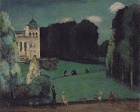|
First issued in Tokyo in 1923, The Taiwan Minpao was eventually released in Taiwan in 1927 and managed by the Taipei Head Office. After repeated petitions came the approval for its publication as a daily in 1932. The Office was then moved to the vicinity of the present-day North Gate near Ximending to cater for its increasing scale, human resources and equipment. Under its modern organization and management were respective departments for editorial, sales and printing. Journalists were recruited through a strict selection process. Thanks to these elites, The Taiwan Minpao saw rapid growth with circulation soaring above 20,000 copies, surpassing Tainan News and rocking the market of pro-government press. To expand the readership, its evening edition was also released in 1934; and to broaden its correspondence territory, new bureaus both domestic and overseas were added. In its heyday, its bureaus all over Taiwan totaled 13, from the initial ones in Hsinchu, Taichung and Tainan gradually extending to East Taiwan, with the Hualien Port Bureau established. Since 1933, there had been overseas expansion with bureaus set up first in Amoy (Xiamen), Shanghai and Dalian, then in Guangdong and Hong Kong after 1941. There were reporters posted in southeast Asia (Nanyang) to strengthen the overseas correspondence network.
Figure 12: Head office of The Taiwan Shinminpo, 1932
Source: Photograph Album of a Charity Concert (T0607P0090_02_0044), Kao Ci-mei Papers (3GCM), Photos of Taiwan Local Autonomy Alliance (LJK_08_01_0060002), Yang Zhao-jia Collection (LJK). The Head office of The Taiwan Minpao was a three-story Western-style building covering an area of 300 m2. It was designed by and constructed under the supervision of American engineers. The first floor housed the printing department; the second floor, the editorial department and the sales department; and the third floor, the conference room, photo room and research room. Adjacent to the main building were the printing press and movable type foundry.
 Figure 13: Opening of Taichung Bureau of The Taiwan Shinminpo, 1932
Source: Photos of Taiwan Local Autonomy Alliance (LJK_08_01_0060002), Yang Zhao-jia Collection (LJK). The Taichung Bureau of The Taiwan Shinminpo was opened in 1932. Seated in the center of the front row was Yang Zhao-jia. The signboard of the Taiwan Local Autonomy Alliance was hanging to the left of the main door, indicating the close ties between running a newspaper and organizing political and social movements.
 Figure 14: Work scenes at The Taiwan Shinminpo printing press, 1934
Source: Manual of The Taiwan Shinminpo (LJK_03_08_0071848), Yang Zhao-jia Collection (LJK). With The Taiwan Shinminpo turned into a daily, the editing and printing work became more intensive, necessitating more supporting staff to be recruited. In 1934, the Head Office alone had 200 staff members working round the clock to produce latest news from information collected from around the world. In order to achieve one-stop operation of editing, printing and distribution, equipment related to movable type printing was purchased, including a type casting machine, which cast 40,000 characters a day for alternate use with old characters. From these photos, one can imagine the hectic work before the deadline of each day when the original news reports were churned out from the editorial office, followed by typesetting at lightning speed and printing tens of thousands of newspapers in the shortest time. Newspaper printing is a race against time!
 Figure 15: Taiwan Jinshikan (Who’s Who in Taiwan) contained introduction of Huang Chou and details of his passport application in 1933
Source: Taiwan Jinshikan (CCP_09_11039_BC4_37), Chen Cheng-po Paintings and Papers (CCP); Foreign Passports Issued, October-December 1933 (T1011_03_139), Passports Issued and Recovered by the Government-General of Taiwan (T1011). Huang Chou, the first Amoy bureau chief of The Taiwan Shinminpo, graduated from Waseda University in Japan. He had a brief visit to Shanghai and Nanjing, China. In 1925, he joined The Taiwan Shinminpo as a reporter and later served as the Taichung bureau chief. Owing to his frequent shuttle between Taiwan and China, he was sent to base in Amoy in October 1933. Records of his application for a passport to Amoy showed that he was accompanied by his wife Li Pien-pien and two young children to his new post.
 Figure 16: Passport records of Kuo Fa and news on his being appointed as Amoy bureau chief, 1938
Source: Foreign Passports Issued, July-September 1938 (T1011_03_158), Passports Issued and Recovered by the Government-General of Taiwan (T1011), The Taiwan Shinminpo No. 2734 (1938-09-13), Records of The Taiwan Shinminpo (T1119). In 1938, The Taiwan Shinminpo also became a press media for Japan during its occupation of Amoy. The then newly appointed Amoy bureau chief, Kuo Fa published more than 30 articles of his observations as a correspondent based in Amoy. The contents had connotations as the propaganda of national policies. |
 |




